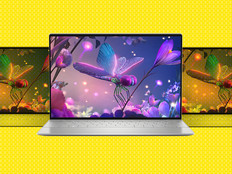Bells But No Whistles
When Sheilagh Morlan flies to client sites, she doesn't carry an ultralight notebook and peripherals but rather a bigger, heavier, all-in-one laptop. "I could get an ultralight unit that weighs less than three pounds, but it's so much easier and professional to just start the computer at the client site than to have to mess around with another eight pounds of external hard disks and peripherals," says Morlan, a support technician with Widevine Technologies in Seattle. "I never have to worry about keeping track of all those extra power supplies and cables."
The kind of notebook road warriors need depends on how much use and abuse their machines will face. Typical office homebodies who travel occasionally, but take their computers home on weekends can make do with a 14-inch screen, a low-end processor and a relatively small hard drive — machines such as the Toshiba Tecra A5-S116 or the ThinkPad G41. Road warriors like Morlan may need sturdier machines with more processing power, at least 512 megabytes of RAM, and a hard drive of 60 gigabytes to 100GB, such as the HP Compaq Business Notebook nc6120 or the Toshiba Tecra S3.
Typical office workers shouldn't bust the budget. Office homebodies don't need a lot of machine as long as it runs Microsoft Office, a browser and e-mail reasonably well. Typically, these employees won't need much hard disk space — the office servers can provide storage — and docking stations provide permanent cable hookups and a means to connect an external keyboard and monitor, so an LCD screen larger than 14 inches is unnecessary. Inexpensive external speakers are useful for listening to multimedia content, online training and the occasional music file, but they're not necessary.
For this class of user, some notebooks to consider are the HP Compaq Business NB nx6110, Toshiba's Tecra A5-S116, the Acer TravelMate 2304LCi-XPP, Lenovo's ThinkPad G41 or the Sony VAIO FS790B01. Each machine offers from between 256MB and 512MB of RAM, 30GB of hard-drive space and enough battery power to get through a two-hour presentation, all (except the Sony) for less than $1,000.
Road Warrior Wish List
Road warriors are the hardest group to buy for because they demand powerful and durable notebooks with a CD-RW/DVD drive, a lot of ports, wired and wireless networking, and good battery life. If there are several groups of road warriors with different sets of requirements (sales vs. training, for example), a notebook with a swappable drive bay can accommodate different needs while maintaining one standard-issue machine to support.
Road warriors probably won't need docking stations (too bulky), but buying a second battery with every notebook that's going on the road will preempt a lot of complaints. Also, purchase 256Mb or 512Mb thumb drives (aka flash drives) for transferring or backing up data files that are bigger than is convenient for a peer-to-peer network transfer.
Hot Tip: Consider making a policy that road warriors connect their notebooks to the network and do a backup whenever they return to the office. While everyone should back up regularly, this is doubly true for road warriors. Their notebooks often get dropped, lost or stolen and connected to various networks, increasing their exposure to viruses and malware.
Angela Dianetti, vice president of finance at Cleveland-based RADCom Inc., lost her notebook to a virus recently. "But because I'd been backing up all my critical files and data to a server using an Ethernet connection, I was back up and running on another notebook in two hours," she says.
Rugged Good Looks
Sometimes it's not enough to give your road warriors a good notebook. If their computers are going to be exposed to moisture, chemicals, dirt, cold, or general abuse, you may want to invest in rugged notebooks. Ruggedized notebooks have magnesium or aluminum alloy cases (as opposed to hardened ABS plastic) and are highly resistant to shocks, jolts, spills, dust and grit.
Rugged notebooks are often used in construction and house appraisal, but are suited for workers in a variety of harsh field conditions. But before rushing out to buy rugged notebooks, weigh the risks of damage and replacement costs against the added cost of a ruggedized model, typically two to three times the cost of a comparably equipped conventional notebook. It's not a small investment, but it may be cheaper in the long run than replacing a notebook every few months.
Like other notebooks, rugged models are highly customizable, and users in extreme conditions typically have very specific needs. Consider rugged notebooks from Panasonic, Introniz, Getac and HP.
Another class of user needs a full-blown desktop replacement, with all the computing power and features of a desktop that can be transported. What these users need is a machine with a 17-inch screen, a high-capacity hard disk for all their tools and files, and lots of RAM and processor power for running demanding applications. (See chart for examples.)
Places to Economize
Few users need every bell and whistle out there. Unless users are doing multimedia creation, give them an on-board graphics chipset rather than a separate graphics card (which will also use more battery). A CD drive or CD-RW burner is fine for office workers — and even road warriors who need a DVD drive aren't likely to need a full DVD burner. Most important, the hottest, fastest processor is overkill for all but the specialists; in fact, the hottest processor may literally be that: it'll burn up the battery faster than a slightly slower — and much cheaper — processor that runs almost as well. As with desktop units, the key to speed is more likely found by having enough RAM: 1Gb of notebook RAM costs $150 or less and can boost performance by 10 percent to 15 percent.
Added bulk also saves money; as a rule, the thinner and lighter a notebook is, the more it costs compared to other models with similar specs. If the users aren't going to be traveling extensively, they might not need a second battery (which will save as much as $200).
Forget About IT
Buying notebooks is always a tradeoff between portability and features, size versus ease of use and low cost or high performance. Each group of users has a different set of requirements, and will make the case for features that add to the glitz factor but don't qualify as a true business need.
Take some time to evaluate the needs and compare them carefully to the notebooks available within your price range. Also look out for these typically cost-effective add-ons:
- More RAM. Not only will more RAM speed your processor (up to a point), but look at the applications your users will be running on the notebooks and see how much RAM they need for optimal performance.
- More hard disk. Even 40GB is a lot of room, but some users may need more than that, particularly if they're generating things off-site such as construction sketches or logging digital photos of work in progress.
- Cigarette lighter adapters to run/charge from the car. These accessories fall into the "cheap-but-really-handy" category; many car chargers are standard equipment for cell phone users.
- Portable printers. A very few users will need a portable printer, but they're invaluable for those who do. Consider looking for units that run from a cigarette lighter attachment; if the users are in the field already, they may be running everything in a car.
All your mobile workers don't need the most powerful and expensive notebook computers.






